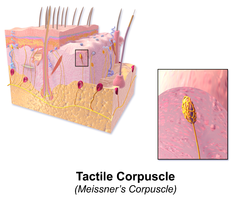| Tactile corpuscle | |
|---|---|
 | |
 Papilla of the hand, magnified 350 times.
| |
| Details | |
| Location | Skin |
| Identifiers | |
| Latin | corpusculum tactus |
| TH | H3.11.06.0.00007 |
| FMA | 83605 |
| Anatomical terms of microanatomy | |
Tactile corpuscles or Meissner's corpuscles are a type of mechanoreceptor discovered by anatomist Georg Meissner (1829–1905) and Rudolf Wagner.[1][2] This corpuscle is a type of nerve ending in the skin that is responsible for sensitivity to pressure. In particular, they have their highest sensitivity (lowest threshold) when sensing vibrations between 10 and 50 hertz. They are rapidly adaptive receptors. They are most concentrated in thick hairless skin, especially at the finger pads.
- ^ "Georg Meissner". www.WhoNamedIt.com. Retrieved 30 January 2017.
- ^ Paré, Michel; Joseph E. Mazurkiewicz; Allan M. Smith; Frank L. Rice (15 September 2001). "The Meissner Corpuscle Revised: A Multiafferented Mechanoreceptor with Nociceptor Immunochemical Properties". The Journal of Neuroscience. 21 (18): 7236–46. doi:10.1523/JNEUROSCI.21-18-07236.2001. PMC 6763005. PMID 11549734.